Lesson topic: “Spelling of unstressed case endings of nouns.
The purpose of the lesson: develop the ability to write correctly unstressed case endings nouns.
Tasks:
Personal:
1. Creation of conditions for the development of interest in the topic under study;
2. Development of independence, friendly attitude, emotional responsiveness.
3. Formation of the ability to listen and hear the interlocutor.
4. To form the ability to cooperate with the teacher and peers in solving educational problems take responsibility for the results of your actions.
Metasubject:
1. Development mental actions: analysis and synthesis, comparison, classification, generalization;
2. To form the ability to accept and save learning goal and tasks.
3. Plan own activities in accordance with the task and the conditions for its implementation, predict the upcoming work.
4. To learn to control and evaluate their actions, to make adjustments to their implementation based on the assessment and taking into account the nature of errors, to show initiative and independence in learning.
Slide number 3
“Patience and hard work will lead to success!”
How do you understand this proverb? What lesson goals does it help us to set?
What spellings are found in this proverb?
Write down today's date and Classwork.
Check your workplace.
Write down the number, class work, underline the spelling
personal, regulatory
Knowledge update.
What topic are we studying? (spelling of unstressed case endings
What is a noun?
Write down nouns to determine the declension and case of nouns.
Mutual verification, exchange terads and check, evaluate this type of work of your friend with a pencil in the margins ( slide5)
Slide6,7
About what time years of ideas speech? How did you guess?
How can we help wintering birds?
Speak the acquired knowledge about the noun.
Do the assignment in your notebook.
They name the rule on which they relied when performing the task.
It became hungry in the forest.
The spotted woodpecker hurries to the spruce.
Ex. - in the forest (2 skl., P. p.), deskl., I. p.), to the spruce (3 skl., D. p.)
Spelling - goal about bottom without. ch., l e su - without. ch., dyat e l - non-conductive. without. ch., sp eat t - without. ch., ate and- without. ending
Feed, hang feeders.
subject
Regulatory, cognitive, communicative
Self-determination to activity.
I invite you to work in pairs
Slide 8
-Connect cards so that they can form phrases.
Write down phrases by changing the endings of nouns
Let's check the work.
What phrases did you get?
Explain the spelling of case endings for nouns.
Formulate a topic. What goals will you set for yourself?
Slide 10
They work in pairs.
Make up phrases by changing the endings of nouns.
Under the guidance of the teacher, the topic and objectives of the lesson are formulated.
Read the resulting phrases.
Swim along the river (1 fold. D. p.), meet my daughter (3 fold., T. p., go out without a hat (1 fold., R. p.), study at the institute (2 fold. P. p.)
Spelling of unstressed case endings of nouns.
Goal: to learn how to write correctly unstressed endings nouns in all cases
Communicative
Regulatory (Goal setting, forecasting, self-assessment)
Work on the topic of the lesson.
- Recall the algorithm to determine the unstressed ending of a noun.
1. Determine the case.
2. Determine the declination.
slide 11
Textbook work.
Do ex. 241 on their own.
Examination.
Name the spellings at the root of the words.
Name nouns with unstressed endings. Explain its spelling.
Remember the algorithm for determining the unstressed ending of a noun.
1. Determine the case.
2. Determine the declination.
3. We remember the ending or substitute a word with a stressed ending of the same type of declension and in the same case.
At the root - in winter, green, green, alive.
Bezud. ending - in a cap e, scarf e oh frost e.
Evaluate your work on self-assessment sheets.
subject
Regulatory
Fizkultminutka.
slide13
Stand up everyone. I will name nouns. If the noun belongs to the 1st declension, you clap your hands, if to the 2nd - hands up, if to the 3rd - hands to the sides.
(Winter, frost, blizzard, blizzard, bullfinch, fur coat, drops)
What word was missing? Why? (Kapel - refers to the spring theme, and all other words - to the winter.)
Declination is determined and the corresponding hand movement is performed.
subject
Regulatory
Consolidation of the studied material.
Organize work in groups.
- Winter has prepared an interesting task for you. Tasks for groups on snowflakes.
Let's remember the rules group work. (Work together, listen to everyone)
Today we will correct mistakes, that is, we will work proofreaders.(a person who works in a publishing house and corrects errors) slide 14
(in the group they discuss and write out the words in which they found errors)
What a beautiful winter forest! The trees are all silver. Everything around is covered with fluffy snow am . The forest is very quiet. Sleeping bear in a den and . On top and a squirrel hid in a tall pine tree. And here is a hare in a white coat and ? He hid around barely.
What errors did you find? (we check along the chain). Raise your hands who agree with them.
What is the spelling of these errors?
(On the spelling of unstressed noun endings)
Organize in groups. Advise and correct mistakes. Prove correct execution.
Snow-ohm, - T. p.2 skl.
In the den - P. p., 1 cl.
At the top - P. p. 1 skl.
In a fur coat - P. p. 1 cl.
Near the spruce - R. p. 3 skl.
On the spelling of unstressed noun endings.
Evaluate your work on self-assessment sheets
Communicative
Regulatory
Creative work.
Guys, I have prepared cards for you, and Winter decided to play a joke on you.
What's wrong with these cards?
Slide 6, this slide will help you
Restore the text, insert appropriate nouns in meaning.
We work in pairs.
Who finished? Continue.
Emphasize unstressed case endings
(Two students read).
What words have unstressed case endings? (snow, on a branch, on top).
Emphasize.
They work in pairs.
Discussing, insert missing nouns.
Who will cope earlier, will continue this text further.
Name nouns with unstressed endings.
(with snow, on a branch, on top)
Communicative
Regulatory
Control and self-test of knowledge
Now let's do a quick poll.
slide 15
Let's test your knowledge of the spelling of unstressed case endings.
Just three questions.
1. Point out the error in the ending.
A) on a rocking chair;
B) for the feeder;
2. Where was the case of the noun wrong?
A) about the house - P. p
B) without fear - V. p.
3. In which line do nouns have the same endings?
A) from notebooks_, about carrots_, near birches_;
B) to uncle_, on the bed_, by the road_.
Who is ready to answer?
Answer test questions.
Check the result.
subject
Regulatory
Homework.
slide16
Ex. 242. Write off, indicate the case of nouns in the first sentence. Additionally creative task: compose a text on the topic "Protect the forest from fire."
The task can be selected and completed partially, for creative work extra score.
Write the assignment in a diary.
Regulatory, personal, subject
Reflection.
Our lesson is coming to an end. With what proverb did we start our lesson. Did she help you?
What topic are we working on?
What knowledge and skills were useful to us in the lesson?
slide17
Complete the sentences
What points did you earn during the lesson?
(children call evaluate)
Worked hard in class...
Thank you for the lesson
Slide 18
Children explain. What was interesting to them, what caused difficulty, what did they learn in the lesson.
Count your scores and rate yourself.
subject
regulatory, educational,
Personal
Winter _________ is similar to ________.
Soft ________ covered __________ with fluffy __________.
The slender ___________ covered herself with soft _______.
________ mysteriously stand wrapped in warm ________.
On _________ the pines bustle _______.
What a beautiful winter _________!
Winter _________ is similar to ________.
Soft ________ covered __________ with fluffy __________.
The slender ___________ covered herself with soft _______.
________ mysteriously stand wrapped in warm ________.
On _________ the pines bustle _______.
What a beautiful winter _________!
Experience shows that one of the most difficult spelling for primary school students is the spelling of case endings -e and -i in nouns. The source of errors in these cases is the sound coincidence of unstressed endings of nouns in combinations like in the village - from the village, in the grove - from the grove, on the site - on the square, etc.
Children very often write the endings in words incorrectly because they determine the case incorrectly. It is difficult for younger students to distinguish between cases. However, it also happens like this: the student correctly writes the endings in words, but he disassembles the forms of nouns incorrectly.
It seemed to be such a simple topic at first glance: “A noun”, but how many important issues are solved when studying it. The most important and important - how to teach to write correctly?
For three years, the teacher has been painstakingly practicing the ability of children to quickly find a noun in a group of other parts of speech according to essential features, preparing them to work at an important stage - spelling endings.
First, it is advisable to introduce students to cases, without correlating them with any particular declension. Children learn about case names case questions. They learn to put questions to nouns when determining the case.
At this initial stage of acquaintance with cases, students do not connect the case of nouns with specific endings.
To clarify the concept of “case”, it is advisable to give students nouns of different declensions (masculine, feminine and neuter; 1st, 2nd, 3rd declension). Then the case will be perceived by children as an indicator of the connection of nouns with other words in a sentence (or phrase). On the this stage it is important that children understand that case depends
from the word with which the noun is associated, and from the question that is posed from another word. For example: who did you see? (what?) dog, bear, lynx - one case (accusative) for all nouns; swim in what? in the river, in the lake, in the bay - one case (prepositional) for all nouns that answer the question where? (In what?).
When studying three types declensions, such an understanding of the case will be affirmed and strengthened. As a result of the initial acquaintance with cases, students will learn that there are six cases in total; each case answers a specific question; any nouns, if they answer the same question, are in the same case (for example: I see whom? a titmouse, a nightingale; I do what? a stool, a table).
In declension, the difference between nouns is in endings, not in cases. Nouns belonging to different declensions differ from each other in endings.
The study of the topic: “Change in cases” occurs in a certain order. First of all, children are given the concept that nouns change in questions depending on other words. After that, there is an acquaintance with individual cases and with case questions. Each case is first taken without prepositions, then students will find out which prepositions are connected with certain cases.
It is very important at first to give nouns with stressed endings, using such types of work as parsing sentences, phrases, establishing a connection between words, making sentences and phrases with studied case forms of nouns, in particular nouns that answer the questions where? where? where?
It is also important that in the process of studying this topic, students clearly compare cases with each other, find out the role of each of the cases and prepositions.
In order for children to understand the difference in the case endings of nouns and write them correctly, it is necessary to teach them to determine the type of declension of nouns according to their generic characteristics. Children must understand that the type of declension can be determined by gender and stress endings: the 1st declension includes them. zh.r. and m.r. With endings -a, -i(earth, sister, ....). Each declension has different endings in the same case.
And then there is the study of each declension separately. Every opportunity is used to compare declensions with each other so that children learn to find their similarities in cases and differences in endings (R. - schools, houses, steppes; D. - school, house, steppes, etc.).
On the other hand, children learn to write unstressed endings correctly by analogy with stressed endings for nouns belonging to the same declension and standing in the same case (by room e, by village e – by water e
).
The task that the teacher faces when studying nouns of the 1st declension in grade IV is to help children understand that the stressed and unstressed endings of nouns of the indicated declension are the same, and to teach children to check the spelling of unstressed noun endings by comparing cases : genitive and dative, genitive, dative and prepositional, etc. The endings of these cases are easy to confuse, so it is important to work out and develop in children the ability to check the spelling of endings by substituting instead of a noun with an unstressed ending a noun of the same declension and the same case with a stressed ending (from villages and- from the earth and ; to the villages e- to the ground e). Now it is easy to learn that the ending of the genitive case is -i (-s), the dative and prepositional cases are e. The ability to distinguish between cases also helps to distinguish endings, for example: near the village (R.p.), in the village (D.p.) , in the village (P.p.). All these words answer the same question where?, but have different endings, because in different cases.
The spelling of the endings of nouns of the 2nd declension causes less difficulty. Unstressed ending prepositional sounds closer to and than to e: "to the houses, parks." Where is the question? characteristic not only for the prepositional case. Therefore, children can be helped by: 1) knowing that the characteristic ending of the prepositional case of nouns of the 2nd declension is -e; 2) comparison with a noun of the same case and declension, but with a stressed ending (to the city e, to the park e, to Smolensk e- to the table e , all L e, to Orel e ).
The 3rd declension is opposed to the 1st and 2nd declension. It is important to show that nouns of the 3rd declension never end in -e, which is only in three cases there is an ending -i (steppes -R.p., to the steppe - D.p., about the steppe - P.p.).
All of the above proves once again that one of the most relevant topics of the Russian language in the spelling of words with unstressed vowels in a word is “Spelling an unstressed vowel at the end of a noun”.
Even the ability to decline nouns and determine their case does not always lead to the correct spelling of this spelling. There are such children in the class who cannot use helper words when writing: children with a low level of attention cannot determine the correct spelling in a word in a timely manner, with a low level of memory they cannot quickly remember the desired ending of a noun in a certain declension and case.
In this situation, the teacher is obliged to use all forms and methods of work in order to achieve a conscious assimilation of this topic and the application of knowledge in practical activities.
Great help in the work of the teacher with the whole class can be provided by cards with individual tasks.
Those. “It is important to strive to ensure that each student works to the best of his ability, feels self-confident, feels the joy of educational work, consciously and firmly assimilates the program material, and advances in development.” (Demeneva N.N. “Differentiation of educational work of younger students)
AT modern education the issue of developing the learning skills of each child at a certain level is being addressed. That is why an individual approach is important, which should be realized through differentiated training.
Using different methods and methods of psychological examination of children (method "Research of verbal-logical thinking", memory study according to the methods of T. Rotanova and Bogdanova T.G., attention - the Bourdon method, observations, oral and written work of children) showed that the degree of learning can be distinguished three groups of children:
the first - with a low degree of learning;
the second - a group with an average degree of learning;
third - group with a high degree learnability.
Fragments of the lesson on the topic: “Noun”
Goals. 1. Learn to compare and write shock and unstressed endings
nouns of the same declension.
2. To form stability and distribution of attention, analytical and synthetic thinking,
self-examination skills.
Explanation of new material
K - No. 1
Look carefully at the table. Decline these words.
1) Read the task on the cards, select the task according to your abilities and complete it.
3) Independent work. (One student of each level performs the task on film, the check is carried out using a codoscope.)
2) Comparison of stressed and unstressed endings of adjectives (starting from level 1).
What shock endings were written out by the guys performing the first card? (viewing and comparing the completed task by students of the 1st level);
- Look carefully at how the guys completed the task on the second card.
What part of the word is stressed?
- At the end.
- Compare the endings from the first card and the second. Make a conclusion.
- Percussive endings.
- Look at card 3. What did you notice in comparison with the first two?
- On the first two cards, the endings are shocked, and on the third - unstressed.
- Who noticed another feature?
- Stressed and unstressed endings of nouns are written the same way.
- What words can be used to help when we write words with an unstressed ending?
RIVER, LAND, YARD, HORSE, WINDOW, STEPPE.
- Read the conclusion on page 82 of the textbook.
Initial check of new material
(differentiation by difficulty level)
K - No. 2
The check is carried out with the help of a codoscope (one student from each level completed the task on the film).
- Read the assignment and check your work and the work of your comrades.
- Name the words - assistants of the 1st, 2nd, 3rd declension.
- Read the task of the second card, take the signals "yes" and "no", let's check our work.
If the guys think that the ending is correct, they show “yes”, if they do not agree, they show “no”.
- What help words do you use in your work?
- (Similar work carried out by checking the third card)
Consolidation of the studied material
(the task can be worked out in two versions)
IN 1.
(Differentiation by volume educational material.)
Exercise assignment:
- Put the nouns in brackets in the correct case. Write phrases.
Determine the case and declension of nouns. Select endings. Mark the accent.
- The first sentence is executed with comments.
- Independent work
1st level - 2, 3 offer;
2nd level - 2, 3, 4 offer;
3rd level - 2, 3, 4, 5 sentence, indicate the test words.
It is carried out using cards with unstressed case endings:
-e, -i, -a, -i, -oh, -hey, -om, -eat, -u, -u.
IN 2.
(Differentiation by level of independence)
Exercise 181 page 83.
- Introduction to the task.
- Children of the 3rd level begin to complete the task.
- With the help of a teacher, students of the 1st and 2nd levels work on 1, 2 sentences.
- Level 2 students continue to work independently, while Level 1 students work independently under the supervision of a teacher.
- Checking the completed task.
(implemented from the 3rd sentence)
Formation of skills and abilities
1st level
Oh pulp ..., in the desert ..., on the ship ..., with joy ..., from lairs ...,
to victories ..., for libraries ..., to the horizon ..., about autumn ..., a handful ...,
oh mouse…, oh drops….2nd level
Write off, stress, determine the declension and case for them. nouns, fill in and highlight the missing ending.
From cereals ... to carnations ..., along the path ... to groves ..., along the aspen ... to the sirens ...,
on the top of the head ... ate ..., from villages ... to rivers ..., near beds ... to cabbages ..., from twigs ... to branches .. .
3rd level
Write phrases according to the given schemes. Noun endings must be unstressed.
In (1cl., f.r.. P.p.) about (2cl., m.r., R.p.)
U (1st class, female, R.p.) (3rd class, R.p.)
On (2cl., m.s., P.p.) to (1st., m.s., D.p.)
U (1cl., f.r., R.p.) on ((1cl., f.r., P.p.)
By (1st class, female, D.p.) to (2nd class, m.s., P.p.)
On (2 skl., Wed, V.p.) to (1 skl., Zh.R., R.p.)
1st level
Write the words in two columns by endings.
On the palm ..., on the poplar ..., from the pain ..., through the rooms ..., about the hero ..., to the regiment ..., to the deoevn ...,
To the competition ..., to green ..., from joy ..., about youth ..., to the flute ....2nd level
Write off. Match the words with the same-root words of another declension in the same case.
On the brooch… - __________________________
Near the bed ... - ____________________
By the cradle ... - ______________________
About the medal ... - ___________________________
In a bottle… -__________________________
Oh night ... - _____________________________
On the snow ... _____________________________
3rd level
- Form 2-3 nouns from verbs: BEND, KILL, SURRENDER, COMPRESS.
- Put the received words in R.p, D.p, P.p., T.p.
(Differentiation by the volume of educational material)
Pick up words - helpers, indicate the declension.
1st level - put their nouns in the form of singular, R.p and V.p.;
2nd level - put their nouns in the singular form, R.p., V.p., D.p.,
3rd level - put their nouns in the singular form, R.p., V.p., D.p., T.p., P.p.
K - No. 8
(Differentiation by level of difficulty and creativity)
1st level - Find in the dictionary the words denoting people and put them in R.p and P.p.
2nd level – Find in the dictionary the words denoting people and put them in R.p. and P.p. .
Find an extra word and explain your choice (passenger - double consonant).
3rd level - Find in dictionary words denoting people and put them in R.p. and P.p.
Divide the words into two groups and explain your decision.Professions of people. Names of people.
Pick up synonyms for the words: soldier, student, comrade, student, teacher.
K-#9
(Differentiation by difficulty level)
1st level
Write off by opening brackets. Put stress, highlight the ending, determine the declension and case.Talk about (fairy tale, story), write in (notebook, notebook), sail on (boat, steamer), swim in (river, lake), meet near (arbor, pier), relax in (village, camp), meet near (gazebo, pier), rushed to (car, horse), talk about (case, life).
2nd level
Write the nouns in three columns, put stress, highlight the ending, indicate the case. (words from the task for the 1st level).3- level
Find and correct the mistakes made, write in brackets test word, highlight the ending, put the stress, determine the case and declension.Talk about fairy tales, stories; write in a notebook, in a notebook; sail on a boat, on a steamer;
Swim in the river, in the lakes ...; meet near the gazebo, pier; relax in the village, in the camp; raced in a car, on a horse; talk about cases, about life.
Primary fixing of the topic:
“Spelling of unstressed endings of nouns x”
K- №10 (differentiation according to the degree of difficulty)
1st level
Determine the declension and case of nouns. Select endings.Without a brush, drop by drop, from the sky, about a river, after a friend ..., to an oak forest, on an ear, over a forest, near a mountain, under a door, at a comrade, about mother, in the sun, to uncle.
2nd level.
Write off, insert and highlight endings, determine the declension and case of nouns.Without cysts ..., drop by drop ..., from the sky ..., about the river ..., after a friend ..., to the oak forest ..., on the ear ..., over the forest ..., at the hills ..., under the door ..., at the comrade ..., oh mother ......, on suns ... to uncles ... .
3-level.
Put nouns in the right case with a suggestion.
Brush - R.p., drop - D.p., river - P.p., (after) friend - R.p., oak forest - D.p.,
Ear - P.p., forest - P.p., hill - D.p., door - R.p., comrade - P.p., mother - P.p.,
Mother - R.p., sun - P.p., uncle - R.p., uncle - P.p.
K - No. 11
1st level
Make sentences using these words; for nouns, highlight the endings, indicate the declension and case.a) because of, the sun, looked out, clouds;
b) by, trips, guys, from, returned, Kaluga;
c) on, hunters, edge, about, rested, piers, forests.
Find extra ones.2nd level
Make sentences using the given words, fill in the missing endings.
Specify the declension and case of nouns.a) from behind, the sun, peeked out, a cloud ...;
b) by, trip ..., guys, from, returned, Kalug ...;
c) on, hunters, edge ..., about, rested, pier ..., forest ....Are all the words needed to make sentences?
Find extra ones. Tell me about its meaning.3rd level
Use these words to make and write sentences. Put the nouns in the right number and case using prepositions.a) the sun, a cloud (singular, R.p.), looked out;
b) guys, trip (singular, R.p.), returned, Kaluga (singular, L.p.)
c) hunters, edge (singular, p.p.), resting, pier (singular, R.p.), forest (singular, R.p.).Are all the words needed to make sentences?
Find the extra. Tell me about its meaning. Pick up words on the same topic as the word marina.
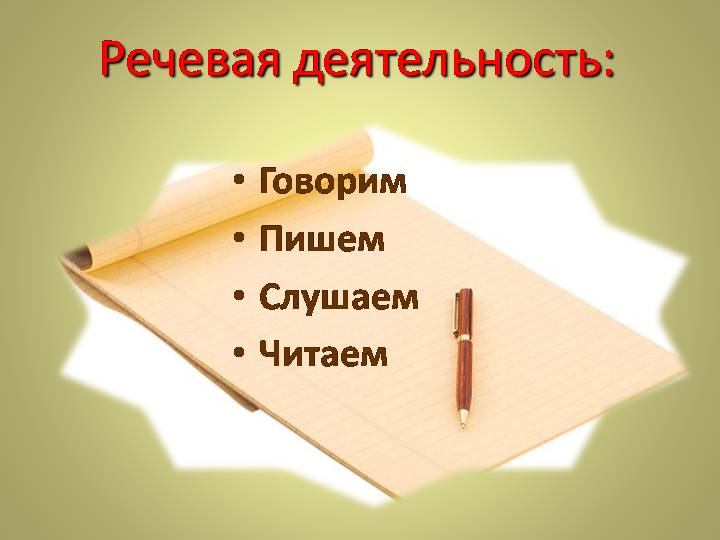


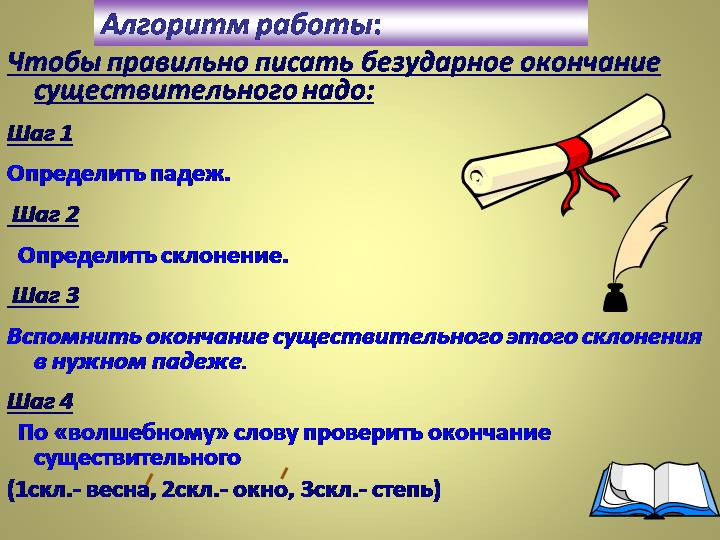

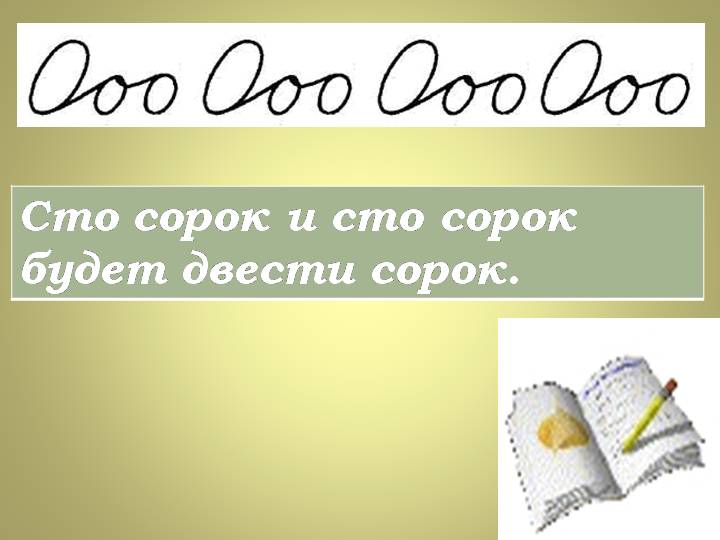
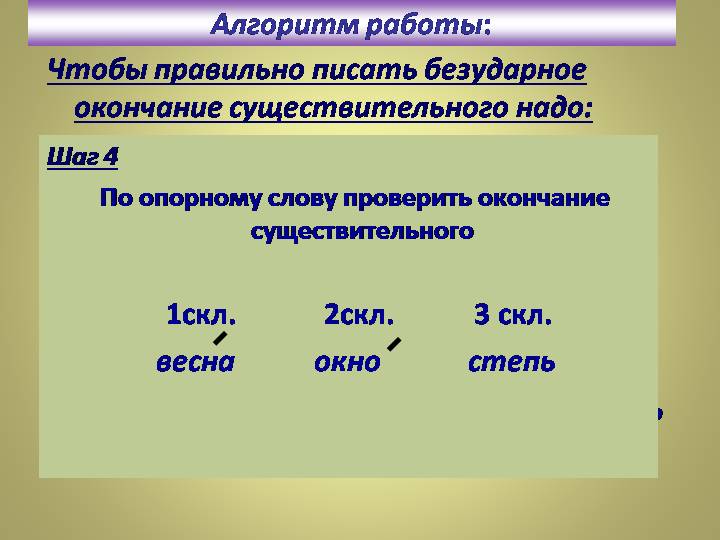
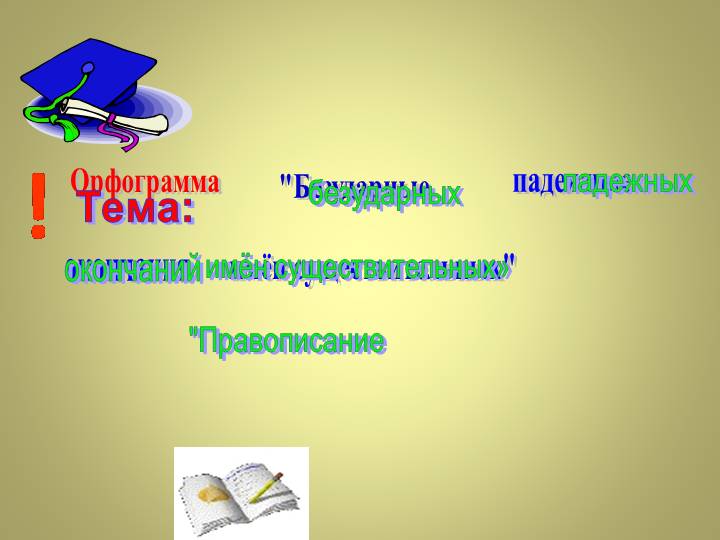
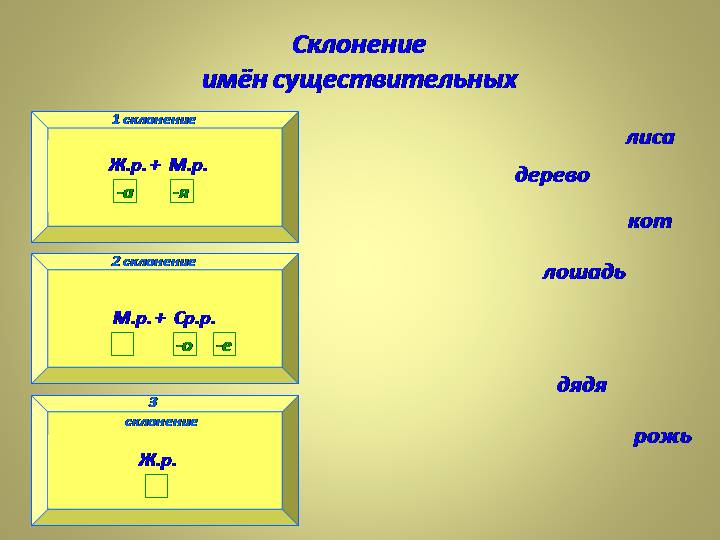


![]()

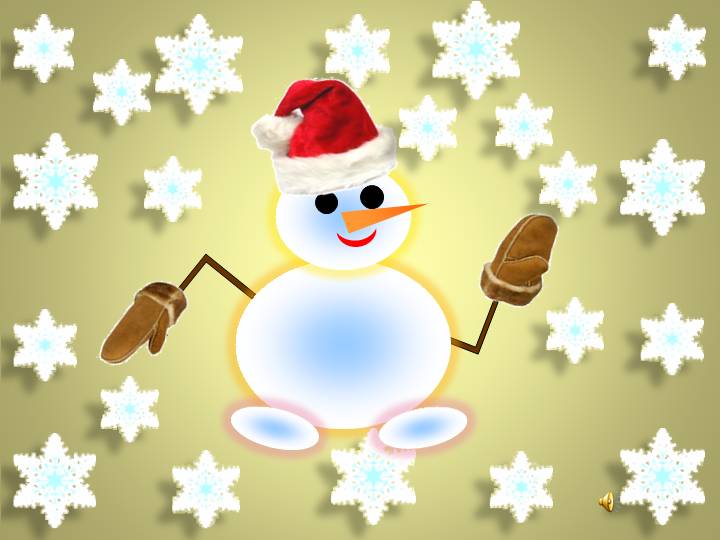

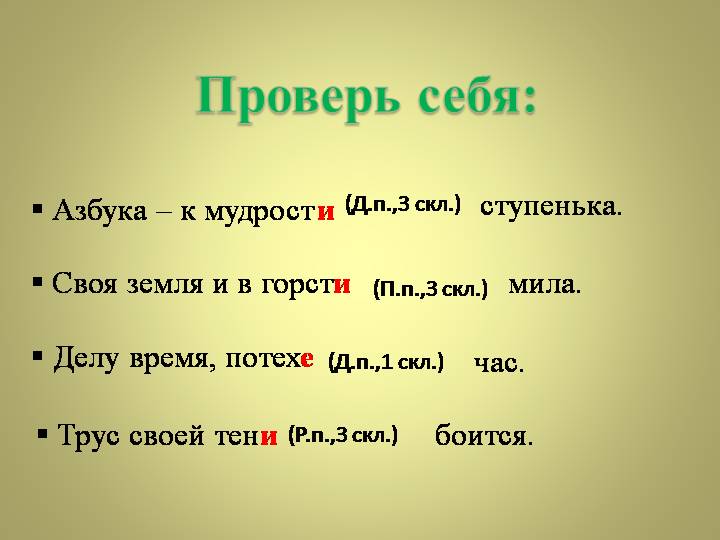

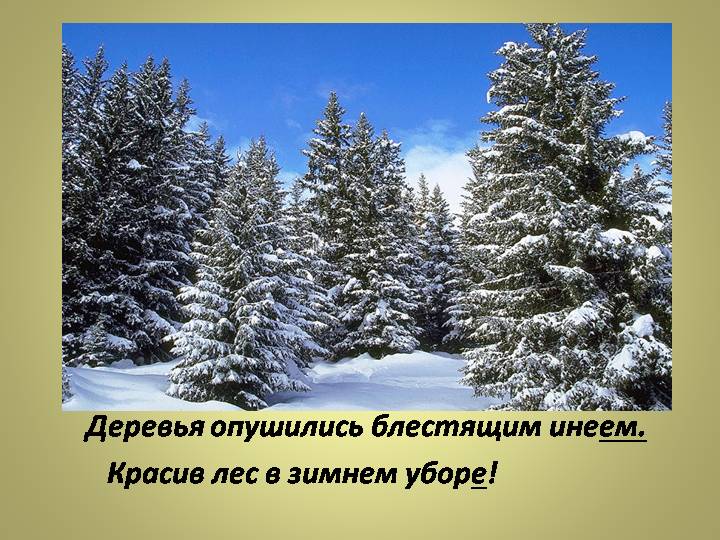
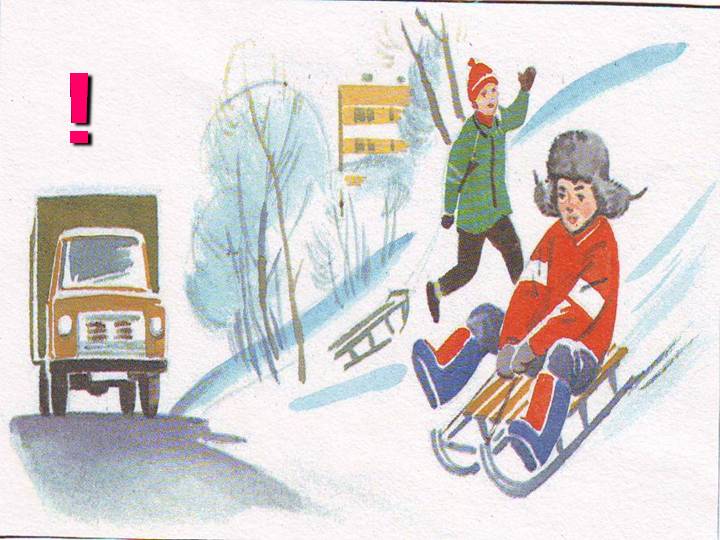
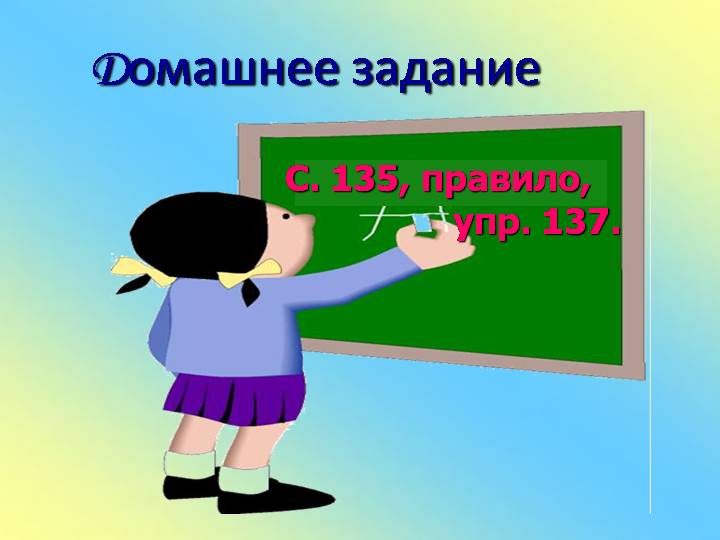
![]()
Enable effects
1 of 22
Embed code
In contact with
Classmates
Telegram
Reviews
Add your review
Annotation to the presentation
Presentation work on the Russian language, which is designed to summarize the study of the topic of unstressed noun endings. In addition to theoretical calculations, the work contains thematic tasks aimed at fixing the material.
Format
pptx (powerpoint)
Number of slides
The audience
The words
Abstract
Present
- Generalizing lesson on unstressed endings of nouns
- Practical tasks
- Working with the textbook
- illustrative examples
Abstract
Kirpushko Natalya Yaroslavovna
MAOUSOSH No. 9, Kaliningrad.
Primary school teacher.
Class: 4-A
Russian language lesson.
-
sl Aid-2
Kinds speech activity:
Speak (click)
Reading (click)
Writing (click)
Listen (click)
What's harder?
Slide 3
II. Knowledge update.
slide 4
What topic are we studying? (Noun)
who? what? and denotes an object)
genus, declension)
(Number, case)
slide 5
2. Determine the declination.
2. Calligraphy
slide 6
Slide 7
- Read.
Slide 8
Slide 9
Attention!
Let's get the topic of the lesson.
parts of words unstressed endings
We remember and generalize
4. Work on the topic of the lesson.
Children: - Three.
Slide 10
Card 1.
slide 11
Card 2.
Let's see how we did...
slide 12
Fizkultminutka. slide 13
5. Fixing
Slide 14 (off projector!!!)
Turn on the projector
2) Work in pairs
slide 15 Find Your Pair Game
Friends are known fun. hour
ABC - to wisdom. in trouble
Own land ten. fears
Cause time step
A coward and a handful. mila
Examination.slide 16
slide 17.
Children: - Winter.
slide 18.
forest, in, dressing, beautiful, winter
slide 19.
(Letter with comment)
slide 20.
7. Homework:
Slide 21.
p.131, exercise 131
8. Reflection Slide 22.
I ________ am satisfied with myself.
(children's answers)
Lesson grades
slide 23.
Kirpushko Natalya Yaroslavovna
MAOUSOSH No. 9, Kaliningrad.
Primary school teacher.
Class: 4-A
Russian language lesson.
Topic: “Spelling of unstressed case endings of singular nouns. Generalization".
Objectives: 1) to generalize knowledge about the spelling of the endings of singular nouns,
2) develop speech, thinking, attentiveness, spelling vigilance;
3) to cultivate interest in the subject.
Equipment: computer, electronic presentation.
Textbook: L.M. Zelenina, T.E. Khokhlova "Russian language", part 1, M, "Enlightenment", 2011
Literature: 1) V.V.Volin "Entertaining alphabet";
2) S.V. Kutyavina " Lesson developments in Russian, 4th grade;
3) L.I. Tikunova, V.P. Kanakina “Collection of dictations and creative works”.
- What types of speech activity do we do in Russian language lessons?
sl Aid-2
Types of speech activity:
Speak (click)
Reading (click)
Writing (click)
Listen (click)
What is easier for you to do in class?
What's harder?
What do you need to know to write well?
Today in the lesson we will continue to work on the study of the secrets of the Russian language.
Slide 3
"No one was born wise, but learned"
How do you understand this proverb?
II. Knowledge update.
slide 4
What topic are we studying? (Noun)
What is a noun? (A noun is a part of speech that answers questions who? what? and denotes an object)
name permanent signs nouns. ( genus, declension)
name fickle signs nouns. (Number, case)
How to write unstressed noun endings? (Algorithm).
slide 5
1. Determine the case of the noun.
2. Determine the declination.
3. Remember the ending of the noun of this declension in the right case.
4. Check with the help of the word-support ("magic")
2. Calligraphy
slide 6
Write down the number and classwork, please check your notes with the writing on the board, pay attention to the spelling.
Today, in calligraphy, we will remember how to connect the letter o.
Slide 7
Write down a line with a letter, pay attention to the connection of letters:
- Read.
One hundred forty and one hundred forty will be two hundred and forty.
Is this statement true? (children's answers)
Why didn’t they immediately guess what it was about, and read it incorrectly? (Because without stress it was not clear what the word "forty" means; words have different meaning are read differently but spelled the same)
3. Reporting the topic of the lesson and setting goals.
We have just made sure that in Russian there are words, so similar friend on the other that they can be confused. Some of them look the same on the letter, but are read differently. Depending on the pronunciation, the meaning of the word and the whole statement changes. Others read the same but are spelled differently.
Slide 8
Let's go back to the slide about writing unstressed noun endings. Step 4
Why did you choose these particular words? (percussive endings)
It turns out according to shock ending we check unstressed, that is, the spelling.
Slide 9
Attention!
Let's get the topic of the lesson.
Today we will find cases in speech when not only whole words are similar to each other, but also parts of words. And our work will be connected with spelling unstressed endings nouns in singular.
We remember and generalize everything we know about the spelling of the endings of nouns.
4. Work on the topic of the lesson.
(2 people to closed boards)
Teacher: - What is called declension?
Children: - Changing the endings of nouns by questions is called changing by cases or declension.
Teacher: - How many declensions are there in Russian?
Children: - Three.
Slide 10
Teacher: - What nouns belong to the 1st declension?
Children: - Male and female nouns female, which in initial form have an ending -a or -я.
Teacher: - What nouns belong to the 2nd declension?
Children: - Nouns male With zero ending in the initial form and neuter nouns with the endings -о, -е or -ё.
Teacher: - What nouns belong to the 3rd declension?
Children: - Feminine nouns with a zero ending in the initial form with a soft stem and with solid foundation on w, sh.
Let's distribute nouns according to the type of declension. fox, uncle, tree, cat, horse, rye
Checking the work of students on a closed board
Card 1.
And at this time ... he worked at the blackboard and this was the task he had.
slide 11
Task: Insert endings. Remember the "magic words"
no mistake .., on the ship ..., to the floor ..., near the square ..., in the dew ..., to the groves ...
What test method did he use? (basic words)
Card 2.
Let's see how we did...
Task: Insert the missing endings, determine the case and declension of nouns. slide 12
To the edge ..., by the horses .., to the river ..., to the entrance ...
What test method did he use? (remembered the table of endings)
Fizkultminutka. slide 13
5. Fixing
Let's consolidate our knowledge by doing the exercise in the textbook
Slide 14 (off projector!!!)
1) Work with the textbook: p.130, exercise 130
(Children write down a sentence. One student works at the blackboard)
Explain the spelling of the missing letters.
turns (on what?) at work (P.p., 1 cl.)
beats (on what?) on the deck (P.p., 1 cl.)
threshes (in what?) in a swamp (P.p., 2 cl.)
Turn on the projector
Physical education for the eyes. slide 16
2) Work in pairs
slide 15 Find Your Pair Game
Friends are known fun. hour
ABC - to wisdom. in trouble
Own land ten. fears
Cause time step
A coward and a handful. mila
Teacher: - Each proverb is divided into 2 parts. Make sentences, write them down by inserting the missing letters.
(Independent work of students in pairs.)
Examination.slide 16
Answer: 1 - reads a proverb, another ending and grammatical signs)
ABC - to wisdom (D.p., 3 fold) step.
Own land and in a handful (P.p., 3 cl.) Sweet.
Business time, fun (D.p., 1 fold) hour.
A coward is afraid of his own shadow (R.p., 3rd line).
slide 17.
3) Working with deformed text.
Teacher: What season is it?
Children: - Winter.
slide 18.
Teacher: According to the calendar, winter begins on December 1. Scientists consider the beginning of winter on December 22. The sun on this day rises low, low in the sky, and the day is the shortest of the year.
And in nature and in our Kaliningrad region winter comes every year at different times.
Let's enjoy the picture winter forest, make proposals and write them down with comments. (click)
pubescent, hoarfrost, trees, shiny
forest, in, dressing, beautiful, winter
slide 19.
(Letter with comment)
Children: - The trees are covered with shiny frost. (E.p., 2 cl)
Beautiful forest in winter dress! (P.t., 2 cl.)
Teacher: What do you like to do in winter?
Children: - Play snowballs, sledding, skating, skiing.
Teacher: - Where can you not sled?
slide 20.
Children: - On the road, you can not drive down the mountain onto the carriageway.
7. Homework:
Slide 21.
p.131, exercise 131
8. Reflection Slide 22.
Today I studied at the lesson ____________
I worked with _____________ mood.
I ________ am satisfied with myself.
I had trouble when _________________.
(children's answers)
Lesson grades
